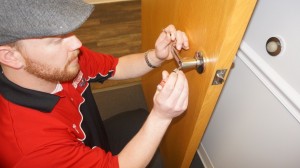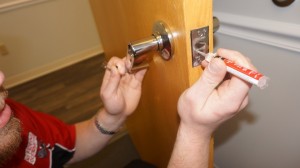Many of us don’t think about lock maintenance on our business or home until the locks fail to work or completely fall off the door. As soon as that happens, the repair becomes a priority because you need to lock or unlock the door and resume your normal schedule.
You may find yourself stranded outside of the office as you wait for a locksmith and that wait can sometimes go well past five o’clock. But you have to stay to make sure you can secure the building before you go home.
It’s a situation no one wants to be in. Luckily, we have some lock maintenance tips to help you avoid those exact scenarios!
Lubrication is Key in Lock Maintenance
First and foremost, as soon as you notice a lock maintenance issue, be pro-active. If your key is particularly hard to turn one morning or if the key won’t move properly into place, lubrication of the cylinder is a good first step.
Lock cylinders consist of small pins and springs that need to move freely to operate correctly. When the inside of the lock is lubricated, the components will begin to move and function properly.
Location is key (no pun intended) with proper lock lubrication. The photos below demonstrate the proper places to apply water based lubricant:
The lubrication of the “keyway” of the lock will get all those aforementioned pins and springs to move again. Don’t be shy either; you really can’t over-lubricate so get inside the cylinder as much as possible.
When you have finished, run your key in and out multiple times to help spread the lubricant around. You will also want to lubricate the bolt or latch on the side of the door. This will help alleviate any problems with the locking mechanism itself.
Hinge Adjustments
Door hinges constantly move every time someone enters or exits a door. Over time they may fail, but more often than not they just need a little lock maintenance TLC.
Each hinge consists of six to eight Phillips head screws that loosen over time. You’ll need a Phillips head screwdriver to tighten each one. Make sure to do both the frame side and the ones attached the door as well.
This will help align the door with the strike, to ensure its latch or bolt is falling into the correct place. It will also stop the door from rubbing against the frame, which could be the reason it was difficult to open or close.
Closer Adjustments
If you have a door closer, it’s there to ensure the door closes properly after someone opens it, but, they need adjustments. If it pulls the door closed too slowly, the door may not latch every time it’s opened. If the door closes too fast and slams, it could loosen or even damage the lockset on the door.
Door closers usually consist of three main adjustments: Swing speed, latch speed, and back check.
The back check adjustment is the final few seconds before the door closes and the lock’s latch falls into place. Not every closer has a back check, but it’s important to adjust and test this a few times to ensure the door isn’t accidentally left open.
The swing speed and latch speed should be adjusted according to the conditions on the door.
If it’s in a windy area, you may want to adjust it to close a little faster so the wind doesn’t catch it and damage anything.
If it’s in an interior office you may want to slow it down so co-workers are not hindered by it as they walk in and out.
Extra Pointers
- Check for daylight between the frame and the door. If you see light between the two, the door may sag or the frame might be damaged. It will be much less expensive to gather quotes now on a repair rather than calling in an emergency when the door stops closing.
- Check the frame and floor for rub marks. You will visibly be able to see when a door is dragging on the ground or against the frame. If you tighten the hinges this may help alleviate this particular issue.
- Crash bars and exit devices need love, too! Make sure to oil them properly. Remove the head and soak it down quarterly. This will help save you from emergencies.
- Check the strike—the part of the frame that the latch or bolt falls into. If that hole is clogged with debris the lock won’t function properly.
- Is the latch exposed? If you stand on the outside of the door and have a wide gap between the frame and door, which exposes the latch, you might want to consider a latch guard to protect it from being pried open.
- Final tip: Find a locksmith before you need one. There are numerous unqualified companies that will charge excessive emergency rates for many of the repairs you read in this blog. Program a local locksmith into your phone or call LockNet to schedule someone for you. You will be happy you did when a problem arises!



